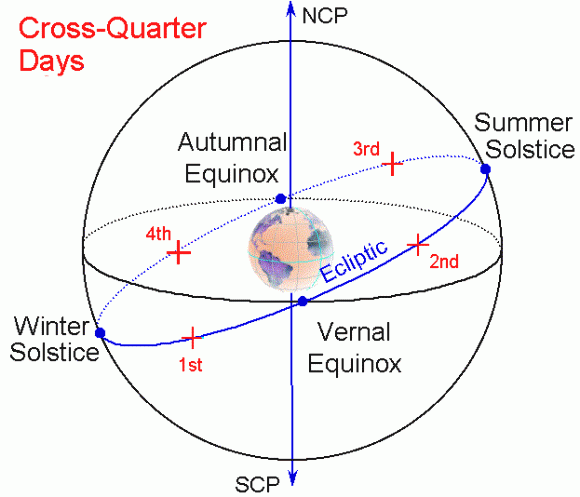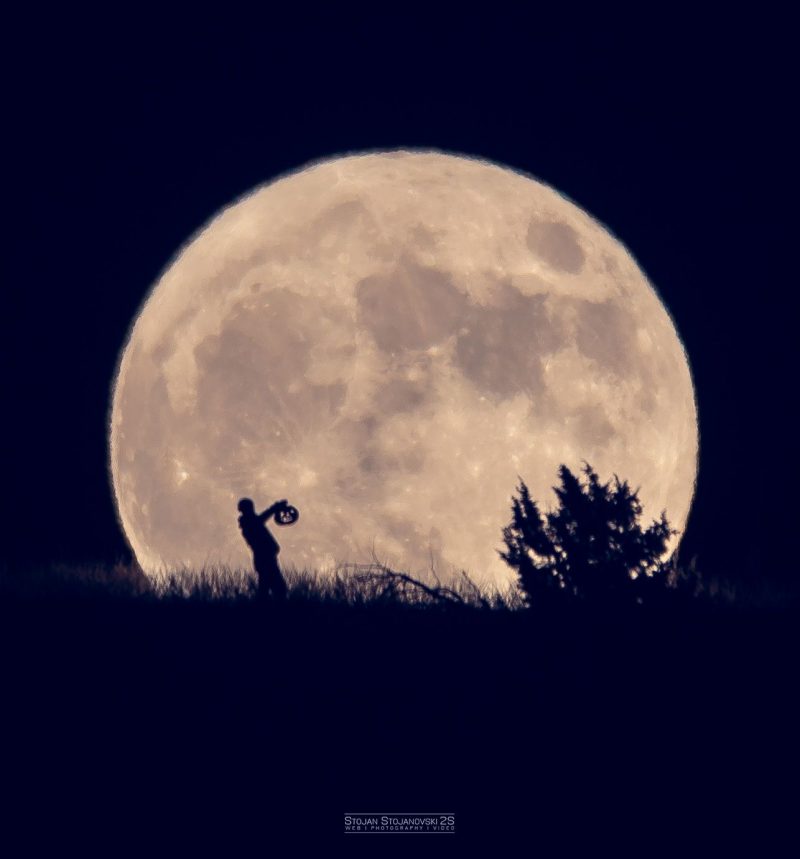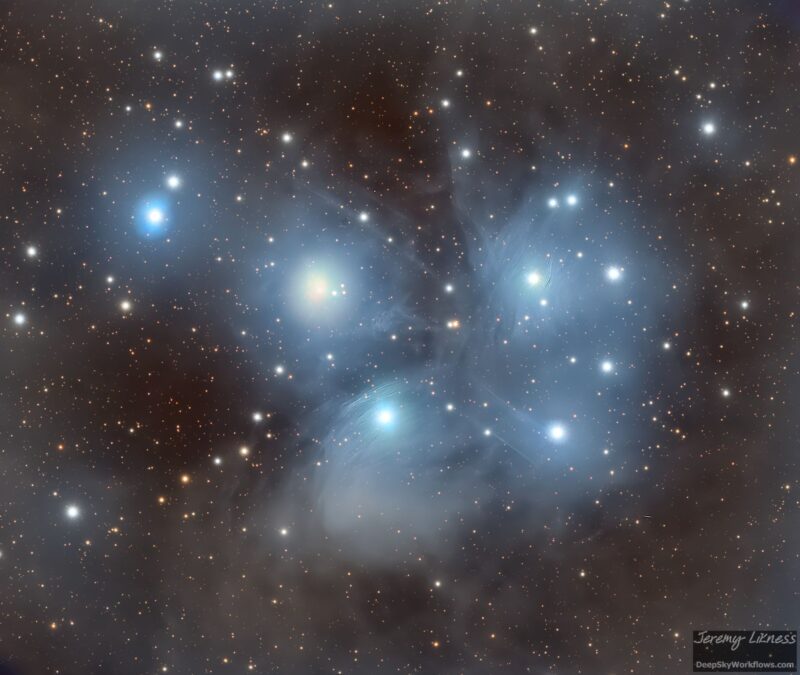Halloween is a cross-quarter day
Sure, Halloween is the modern-day descendant of Samhain, a sacred festival of the ancient Celts and Druids in the British Isles. And, yes, Halloween is short for All Hallows’ Eve. But, at its heart, Halloween is an astronomy holiday. It’s a day rooted in Earth’s orbit around the sun. It’s a cross-quarter day and a testament to our ancestors’ deep understanding of the sky.
The cross-quarter days fall more or less midway between the equinoxes (when the sun sets due west) and solstices (when the sun sets at its most northern or southern point on the horizon). Halloween – October 31 – is approximately midway between our Northern Hemisphere autumn (September) equinox and winter (December) solstice In the Southern Hemisphere, the September equinox heralds spring and the December solstice, summer.
In other words, in traditional astronomy, there are eight major seasonal subdivisions of every year. They include the March and September equinoxes, the June and December solstices, and the intervening four cross-quarter days.
In modern times, the four cross-quarter days are often called Groundhog Day (February 2), May Day (May 1), Lammas (August 1) and – the most sinister cross-quarter day because it comes at a dark time of year – Halloween (October 31).
Halloween falls at a dark time of year
For us in the Northern Hemisphere, Halloween is the darkest of the cross-quarter days. And it comes at a time of year when the days are growing shorter. Early people once said that the spirits of the dead wander from sunset until midnight around this cross-quarter day. After midnight – on November 1, now called All Saints’ Day – the ghosts supposedly go back to rest.
The October 31 date for Halloween is fixed by tradition. The true cross-quarter day falls on November 7, representing a discrepancy of about a week. According to the ancient Celts, a cross-quarter day marks the beginning – not the middle – of a season.

The Pleiades connection
Some believe that the early forebear of Halloween – Samhain – happened on the night that the Pleiades star cluster culminated at midnight.
In other words, the Pleiades climbed to its highest point in the sky at midnight on or near the same date as this cross-quarter day. Now, the midnight culmination of the Pleiades cluster now occurs on November 21, but Halloween is fixed on October 31.
Presuming the supposed connection between Samhain and the midnight culmination of the Pleiades, the two events took place on or near the same date in the 11th century (1001-1100) and 12th century (1101-1200). This was several centuries before the introduction of the Gregorian calendar.
At that time, when the Julian calendar was in use, the cross-quarter day and the midnight culmination of the Pleiades fell – amazingly enough – on or near October 31. But, then, the Julian calendar was about one week out of step with the seasons. Had the Gregorian calendar been in use back then, the date of the cross-quarter day celebration would have been November 7.
Calendar converter via Fourmilab
But Halloween falls on October 31 now. Meanwhile, the true cross-quarter day happens on or near November 7. And the midnight culmination of the Pleiades cluster is on or near November 21.

Pleiades is associated with Halloween

Bottom line: October 31, the date for Halloween, marks the approximate midway point between the September equinox and the December solstice. So Halloween is an astronomy holiday, and one of the year’s four cross-quarter days.
Read about another cross-quarter day, Groundhog Day
May Day is a cross-quarter day
Enjoying EarthSky? Sign up for our free daily newsletter today!
The post Halloween is an astronomy holiday. It’s a cross-quarter day first appeared on EarthSky.
from EarthSky https://ift.tt/Zx8Qk1s
Halloween is a cross-quarter day
Sure, Halloween is the modern-day descendant of Samhain, a sacred festival of the ancient Celts and Druids in the British Isles. And, yes, Halloween is short for All Hallows’ Eve. But, at its heart, Halloween is an astronomy holiday. It’s a day rooted in Earth’s orbit around the sun. It’s a cross-quarter day and a testament to our ancestors’ deep understanding of the sky.
The cross-quarter days fall more or less midway between the equinoxes (when the sun sets due west) and solstices (when the sun sets at its most northern or southern point on the horizon). Halloween – October 31 – is approximately midway between our Northern Hemisphere autumn (September) equinox and winter (December) solstice In the Southern Hemisphere, the September equinox heralds spring and the December solstice, summer.
In other words, in traditional astronomy, there are eight major seasonal subdivisions of every year. They include the March and September equinoxes, the June and December solstices, and the intervening four cross-quarter days.
In modern times, the four cross-quarter days are often called Groundhog Day (February 2), May Day (May 1), Lammas (August 1) and – the most sinister cross-quarter day because it comes at a dark time of year – Halloween (October 31).
Halloween falls at a dark time of year
For us in the Northern Hemisphere, Halloween is the darkest of the cross-quarter days. And it comes at a time of year when the days are growing shorter. Early people once said that the spirits of the dead wander from sunset until midnight around this cross-quarter day. After midnight – on November 1, now called All Saints’ Day – the ghosts supposedly go back to rest.
The October 31 date for Halloween is fixed by tradition. The true cross-quarter day falls on November 7, representing a discrepancy of about a week. According to the ancient Celts, a cross-quarter day marks the beginning – not the middle – of a season.

The Pleiades connection
Some believe that the early forebear of Halloween – Samhain – happened on the night that the Pleiades star cluster culminated at midnight.
In other words, the Pleiades climbed to its highest point in the sky at midnight on or near the same date as this cross-quarter day. Now, the midnight culmination of the Pleiades cluster now occurs on November 21, but Halloween is fixed on October 31.
Presuming the supposed connection between Samhain and the midnight culmination of the Pleiades, the two events took place on or near the same date in the 11th century (1001-1100) and 12th century (1101-1200). This was several centuries before the introduction of the Gregorian calendar.
At that time, when the Julian calendar was in use, the cross-quarter day and the midnight culmination of the Pleiades fell – amazingly enough – on or near October 31. But, then, the Julian calendar was about one week out of step with the seasons. Had the Gregorian calendar been in use back then, the date of the cross-quarter day celebration would have been November 7.
Calendar converter via Fourmilab
But Halloween falls on October 31 now. Meanwhile, the true cross-quarter day happens on or near November 7. And the midnight culmination of the Pleiades cluster is on or near November 21.

Pleiades is associated with Halloween

Bottom line: October 31, the date for Halloween, marks the approximate midway point between the September equinox and the December solstice. So Halloween is an astronomy holiday, and one of the year’s four cross-quarter days.
Read about another cross-quarter day, Groundhog Day
May Day is a cross-quarter day
Enjoying EarthSky? Sign up for our free daily newsletter today!
The post Halloween is an astronomy holiday. It’s a cross-quarter day first appeared on EarthSky.
from EarthSky https://ift.tt/Zx8Qk1s

Aucun commentaire:
Enregistrer un commentaire